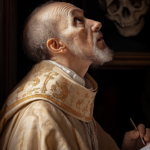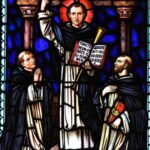St. Robert Bellarmine
St. Robert Bellarmine
When they lived:
St. Robert Bellarmine, also known as Saint Roberto Bellarmino in Italian, lived from October 4, 1542, to September 17, 1621. He was a prominent figure of the late Renaissance and the early Baroque period.
Where they lived:
St. Robert Bellarmine was born in the city of Montepulciano, located in the Tuscany region of Italy. He spent much of his life in various Italian cities, including Rome and Padua, and eventually passed away in Rome.
Notable world events during the time of their life:
- Counter-Reformation (16th and 17th centuries): St. Robert Bellarmine played a significant role in the Counter-Reformation, a period of Catholic resurgence and reform in response to the Protestant Reformation. He engaged in theological debates and wrote extensively to defend Catholic doctrine.
- Galileo Galilei’s Observations (17th century): During Bellarmine’s lifetime, the famous astronomer Galileo Galilei made groundbreaking observations with his telescope. Bellarmine engaged in a correspondence with Galileo regarding the Church’s stance on heliocentrism, marking an intersection between science and religion.
- Thirty Years’ War (1618-1648): The Thirty Years’ War was one of the most destructive conflicts in European history, encompassing religious, political, and dynastic struggles. Bellarmine’s death in 1621 occurred during the early stages of this war, and the conflict continued to reshape Europe’s religious and political landscape.
- The Establishment of the Gregorian Calendar (1582): In 1582, Pope Gregory XIII introduced the Gregorian calendar to reform the Julian calendar. This reform corrected inaccuracies in dating and remains the calendar system used worldwide today.
- Foundation of the Jesuit Order (1540): St. Robert Bellarmine was a member of the Society of Jesus, commonly known as the Jesuits. The Jesuits played a significant role in the Counter-Reformation, and their influence on education and missionary work was profound during this era.
- Exploration and Colonialism: The age of exploration and colonialism was in full swing during Bellarmine’s lifetime. European powers were establishing colonies across the Americas, Africa, and Asia, leading to profound global changes.
- Rise of Baroque Art and Architecture: The Baroque period in art and architecture emerged during Bellarmine’s lifetime. This ornate and dramatic style had a lasting impact on European culture and can be seen in many churches and buildings of the time.
Their patronage:
St. Robert Bellarmine is the patron saint of catechists, catechumens, and the Archdiocese of Cincinnati. His significant contributions to Catholic theology and his commitment to teaching and defending the faith make him a fitting patron for those involved in religious education and instruction. Moreover, his interactions with Galileo and the relationship between faith and science also make him a symbol of the ongoing dialogue between religion and scientific inquiry. Bellarmine’s life exemplifies the intellectual and spiritual ferment of his era, and his legacy continues to inspire both Catholics and scholars today.
A Rising Theologian
St. Robert Bellarmine was born on October 4, 1542, in Montepulciano, near Siena, Italy. He was the nephew, on his mother’s side, of Pope Marcellus II. He had an excellent academic formation in the humanities prior to his entry into the Society of Jesus on September 20, 1560. At the Roman College in Padua and at Louvain, both his philosophical and theological studies focused on St. Thomas Aquinas and the Fathers of the Church. These were very important and crucial to his theological inclination.
Robert Bellarmine was ordained to the priesthood on March 25, 1570. For some years, he was a professor of theology in Louvain. Later on, he was summoned to Rome by Pope Gregory XIII, where he was assigned to teach at the Roman College. While he was there, he was entrusted with the chair of apologetics. During the decade of his post, he compiled a series of lessons that subsequently formed the Controversiae, an opus whose clarity, richness in content, and generally historical tone had earned it renown.
The Council of Trent had just concluded in the face of the Protestant Reformation. The Catholic Church was obliged to reinforce, strengthen, and confirm her identity. In this context, Bellarmine’s action fits. From 1588 until 1594, he was assigned as the first spiritual director of the Jesuit students at the Roman College. Among these students whom he met and gave direction was Aloysius Gonzaga, who later became a saint. After some time, he became the religious superior.
Bellarmine’s untiring service
Pope Clement VIII appointed Bellarmine to various offices, namely, as papal theologian, consultor to the Holy Office, and rector of the College of Confessors at St. Peter’s. Some years later, he was created cardinal on March 3, 1599, by the same Pontiff and was appointed Archbishop of Capua on March 18, 1602. In his three years as bishop, he distinguished himself by his zeal as an outstanding preacher in his cathedral, by his weekly visitations to parishes, by the Diocesan Synods, and by a Provincial Council that he established. Although he was named a cardinal, he lived a humble and caring life. He gave most of his money to the poor. While he had little regard for his own comforts, he always saw to it that his servants and aides had everything they needed.
Cardinal Bellarmine took part in the conclaves that elected Pope Leo XI and Pope Paul V. After this, he was called to Rome again, where he was appointed a member of the Congregations of the Holy Office, of the Index, for the Rites, for Bishops, and for the Propagation of the Faith. He also held diplomatic responsibilities in the Republic of Venice and in England to defend the rights of the Apostolic See.
In his last years, Cardinal Bellarmine composed various works on spirituality in which he concentrated on the results of his yearly spiritual exercises. On September 17, 1621, Cardinal Bellarmine died in Rome. He was beatified by Pope Pius XI in 1923, canonized in 1930, and proclaimed a Doctor of the Church in 1931. His feast day is September 17.
Five Interesting Facts About St. Robert Bellarmine
- St. Robert Bellarmine is one of the patron saints of catechists and catechumens.
- Under the order of Pope Paul V in 1616, St. Robert Bellarmine notified Galileo Galilei that his heliocentric theory was opposed to biblical teaching and could not be supported by the Church at the time.
- St. Robert Bellarmine was St. Aloysius Gonzaga’s spiritual director and was also present during the latter’s death in 1591. St. Robert Bellarmine helped get St. Aloysius Gonzaga beatified.
- A story was told about a miracle attributed to St. Robert Bellarmine. When he was walking on the banks of a river one night, he caught sight of fishermen who had no catch. He told the men to lower the nets and leave them for a while, and with a loud voice he cried out “Come, fish, come!”, The fishermen lifted their nets filled with fish.
- St. Robert Bellarmine wrote a hymn to Mary Magdalene. This hymn is now included in the Roman Breviary.
Prayer to St. Robert Bellarmine
O God, who adorned the Bishop Saint Robert Bellarmine with wonderful learning and virtue to vindicate the faith of your Church, grant, through his intercession, that in the integrity of that same faith, your people may always find joy. Through our Lord Jesus Christ, your Son, who lives and reigns with you in the unity of the Holy Spirit, one God, for ever and ever Amen.



